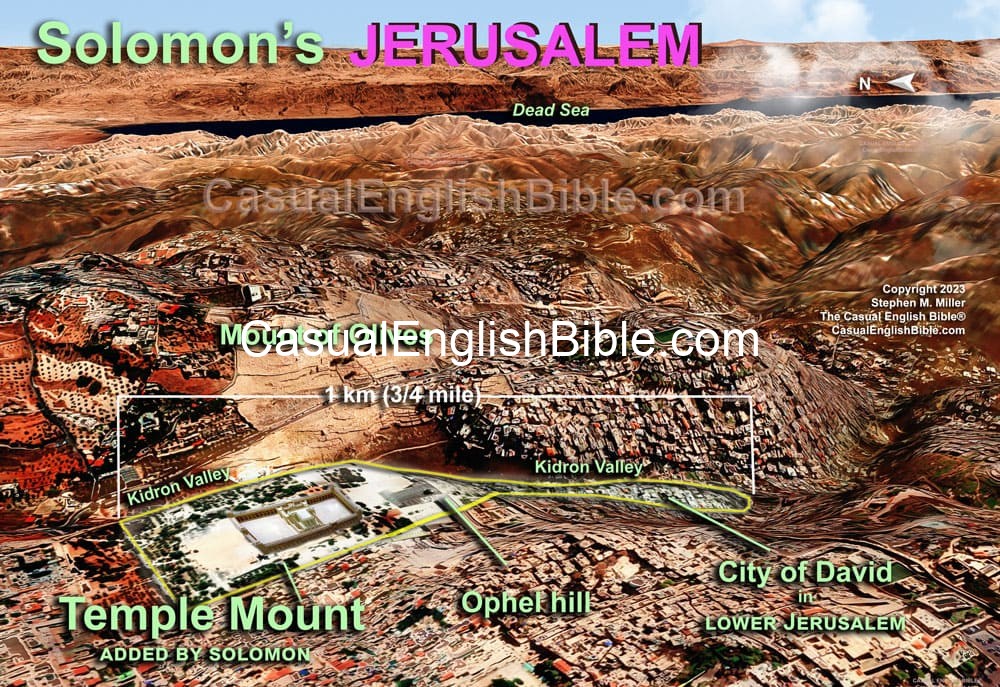2 Chronicles 27
King Jotham leads a strong Judah
Good king Jotham
2 Kings 15:32-38 1 Jotham was 25 years old when he became king, and he ruled for 16 years out of his capital city of Jerusalem. His mother was Jerusha, a daughter of Zadok.
2Jotham was a good king, devoted to God—just like his dad had been most of the time. Unlike his father, Jotham didn’t break God’s law by going inside the Temple—a sacred building reserved for priests. Even so, many didn’t follow his example. They didn’t follow God’s rules for living. They followed their own.
3Jotham built the Upper Gate, which led into the Temple courtyard. And he did a lot of work on the wall at the hill of Ophel. [1] 4He also built cities throughout the hills of Judah. He also built defensive forts and lookout towers on hilltops in wooded areas. King Jotham defeats Ammon
5His army fought and defeated soldiers of the neighboring nation of Ammon. [2] As a result, Ammon had to pay Judah tribute taxes for the next three years. The fee each year was almost four tons of silver, 50,000 bushels of wheat and another 50,000 bushels of barley. [3]
6Jotham grew more powerful because he followed God’s rules for living. 7The rest of Jotham’s story with all he accomplished is preserved in the History of the Kings of Israel and Judah. [4]
8He was 25 years old when he became king, and he ruled for 16 years in Jerusalem. 9Jotham died at the age of 41. He was buried with his ancestors in the City of David. [5] His son Ahaz became the next king. Footnotes
127:3Jerusalem sits on top of a ridge of hills across the Kidron Valley from the Mount of Olives, which is also a ridge of hills. On Jerusalem’s ridge, Ophel was the hill where some people lived inside the walled city. Ophel was on the south side of Mount Moriah, the hill where the Temple stood.
227:5Ammonites had been perpetual enemies of the Jewish people since the time Jews returned from slavery in Egypt and began resettling in what was then called Canaan, today’s Israel and Palestinian Territories (Judges 3:13; 10:8).
327:5The fee was 7,500 pounds (3.4 metric tons) of silver. In the ancient Hebrew system of measurement, it was 100 talents. That’s about the weight of a heavy-duty pickup truck, a delivery truck, or an Asian elephant (smaller than African ones). The amount of grain was 1,000 metric tons, or 10,000 cors in the Hebrew system. That amount of grain would fill 13 of the typical 62-foot-long (19-meter) railroad cars.
427:7This was a lost book or part of a collection of lost books apparently filled with more details about the Israelite kings of Israel and Judah. Some scholars say they consider those books lost books of the Bible.
527:9The City of David was the original part of town before Solomon expanded up the hill to add the Temple and palace complexes.
Discussion Questions
- Sorry, there are currently no questions for this chapter.
Videos
2Jotham was a good king, devoted to God—just like his dad had been most of the time. Unlike his father, Jotham didn’t break God’s law by going inside the Temple—a sacred building reserved for priests. Even so, many didn’t follow his example. They didn’t follow God’s rules for living. They followed their own.
3Jotham built the Upper Gate, which led into the Temple courtyard. And he did a lot of work on the wall at the hill of Ophel. [1] 4He also built cities throughout the hills of Judah. He also built defensive forts and lookout towers on hilltops in wooded areas.
King Jotham defeats Ammon
5His army fought and defeated soldiers of the neighboring nation of Ammon. [2] As a result, Ammon had to pay Judah tribute taxes for the next three years. The fee each year was almost four tons of silver, 50,000 bushels of wheat and another 50,000 bushels of barley. [3]6Jotham grew more powerful because he followed God’s rules for living. 7The rest of Jotham’s story with all he accomplished is preserved in the History of the Kings of Israel and Judah. [4]
8He was 25 years old when he became king, and he ruled for 16 years in Jerusalem. 9Jotham died at the age of 41. He was buried with his ancestors in the City of David. [5] His son Ahaz became the next king.
Footnotes
Jerusalem sits on top of a ridge of hills across the Kidron Valley from the Mount of Olives, which is also a ridge of hills. On Jerusalem’s ridge, Ophel was the hill where some people lived inside the walled city. Ophel was on the south side of Mount Moriah, the hill where the Temple stood.
Ammonites had been perpetual enemies of the Jewish people since the time Jews returned from slavery in Egypt and began resettling in what was then called Canaan, today’s Israel and Palestinian Territories (Judges 3:13; 10:8).
The fee was 7,500 pounds (3.4 metric tons) of silver. In the ancient Hebrew system of measurement, it was 100 talents. That’s about the weight of a heavy-duty pickup truck, a delivery truck, or an Asian elephant (smaller than African ones). The amount of grain was 1,000 metric tons, or 10,000 cors in the Hebrew system. That amount of grain would fill 13 of the typical 62-foot-long (19-meter) railroad cars.
This was a lost book or part of a collection of lost books apparently filled with more details about the Israelite kings of Israel and Judah. Some scholars say they consider those books lost books of the Bible.
The City of David was the original part of town before Solomon expanded up the hill to add the Temple and palace complexes.
Discussion Questions
- Sorry, there are currently no questions for this chapter.






